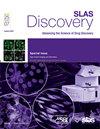Comparative evaluation of cell-based assay technologies for scoring drug-induced condensation of SARS-CoV-2 nucleocapsid protein
IF 2.7
4区 生物学
Q2 BIOCHEMICAL RESEARCH METHODS
引用次数: 0
Abstract
Protein-nucleic acid phase separation has been implicated in many diseases such as viral infections, neurodegeneration, and cancer. There is great interest in identifying condensate modulators (CMODs), which are small molecules that alter the dynamics and functions of phase-separated condensates, as a potential therapeutic modality. Most CMODs were identified in cellular high-content screens (HCS) where micron-scale condensates were characterized by fluorescence microscopy. These approaches lack information on protein dynamics, are limited by microscope resolution, and are insensitive to subtle condensation phenotypes missed by overfit analysis pipelines. Here, we evaluate two alternative cell-based assays: high-throughput single molecule tracking (htSMT) and proximity-based condensate biosensors using NanoBIT (split luciferase) and NanoBRET (bioluminescence resonance energy transfer) technologies. We applied these methods to evaluate condensation of the SARS-CoV-2 nucleocapsid (N) protein under GSK3 inhibitor treatment, which we had previously identified in our HCS campaign to induce condensation with well-defined structure-activity relationships (SAR). Using htSMT, we observed robust changes in N protein diffusion as early as 3 h post GSK3 inhibition. Proximity-based N biosensors also reliably reported on condensation, enabling the rapid assaying of large compound libraries with a readout independent of imaging. Both htSMT and proximity-based biosensors performed well in a screening format and provided information on CMOD activity that was complementary to HCS. We expect that this expanded toolkit for interrogating phase-separated proteins will accelerate the identification of CMODs for important therapeutic targets.
基于细胞的药物诱导的SARS-CoV-2核衣壳蛋白凝集检测技术的比较评价。
蛋白质-核酸相分离涉及许多疾病,如病毒感染、神经变性和癌症。凝析物调节剂(CMODs)是一种可以改变相分离凝析物的动力学和功能的小分子,是一种潜在的治疗方式。大多数CMODs是在细胞高含量筛选(HCS)中鉴定的,其中微米尺度的凝聚物是用荧光显微镜表征的。这些方法缺乏蛋白质动力学的信息,受显微镜分辨率的限制,并且对过拟合分析管道遗漏的细微冷凝表型不敏感。在这里,我们评估了两种可选的基于细胞的检测方法:高通量单分子跟踪(htSMT)和基于邻近的冷凝生物传感器,使用NanoBIT(分裂荧光素酶)和NanoBRET(生物发光共振能量转移)技术。我们应用这些方法来评估GSK3抑制剂处理下SARS-CoV-2核衣壳(N)蛋白的缩聚,我们之前在HCS活动中发现了这种方法,可以诱导具有明确结构-活性关系(SAR)的缩聚。使用htSMT,我们观察到早在GSK3抑制后3小时N蛋白扩散的强劲变化。基于接近度的N生物传感器也可靠地报告了缩合,使大型化合物文库的快速分析具有独立于成像的读数。htSMT和基于邻近的生物传感器在筛选格式中表现良好,并提供了CMOD活性的信息,这是对HCS的补充。我们期望这个扩展的工具可以用于询问相分离蛋白,从而加速识别用于重要治疗靶点的CMODs。
本文章由计算机程序翻译,如有差异,请以英文原文为准。
求助全文
约1分钟内获得全文
求助全文
来源期刊

SLAS Discovery
Chemistry-Analytical Chemistry
CiteScore
7.00
自引率
3.20%
发文量
58
审稿时长
39 days
期刊介绍:
Advancing Life Sciences R&D: SLAS Discovery reports how scientists develop and utilize novel technologies and/or approaches to provide and characterize chemical and biological tools to understand and treat human disease.
SLAS Discovery is a peer-reviewed journal that publishes scientific reports that enable and improve target validation, evaluate current drug discovery technologies, provide novel research tools, and incorporate research approaches that enhance depth of knowledge and drug discovery success.
SLAS Discovery emphasizes scientific and technical advances in target identification/validation (including chemical probes, RNA silencing, gene editing technologies); biomarker discovery; assay development; virtual, medium- or high-throughput screening (biochemical and biological, biophysical, phenotypic, toxicological, ADME); lead generation/optimization; chemical biology; and informatics (data analysis, image analysis, statistics, bio- and chemo-informatics). Review articles on target biology, new paradigms in drug discovery and advances in drug discovery technologies.
SLAS Discovery is of particular interest to those involved in analytical chemistry, applied microbiology, automation, biochemistry, bioengineering, biomedical optics, biotechnology, bioinformatics, cell biology, DNA science and technology, genetics, information technology, medicinal chemistry, molecular biology, natural products chemistry, organic chemistry, pharmacology, spectroscopy, and toxicology.
SLAS Discovery is a member of the Committee on Publication Ethics (COPE) and was published previously (1996-2016) as the Journal of Biomolecular Screening (JBS).
 求助内容:
求助内容: 应助结果提醒方式:
应助结果提醒方式:


